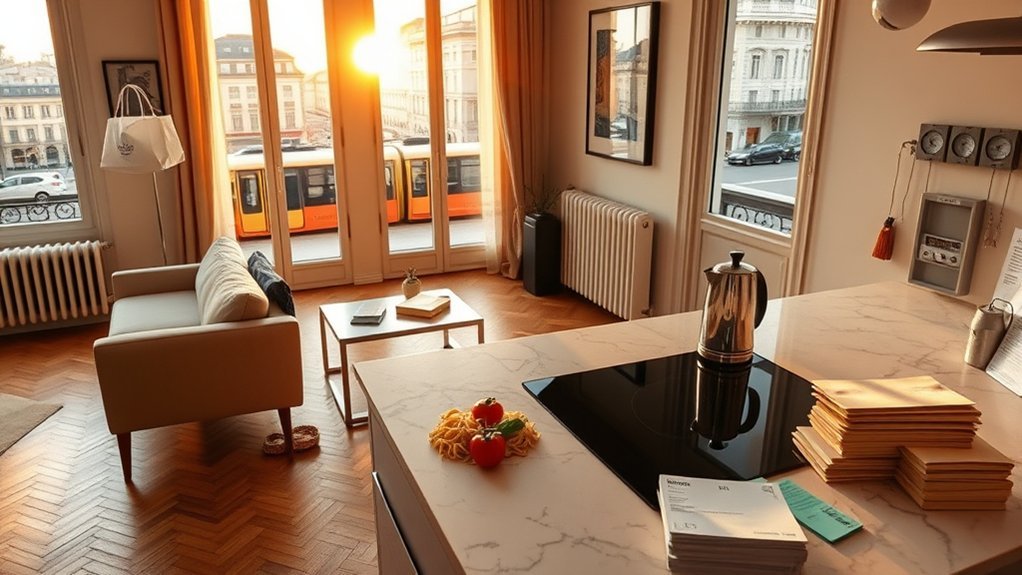You’ll need roughly €2,000–€2,400 net per month to live comfortably in Milan, with rent taking the largest share: expect €1,200–€2,000 for a central 1‑bed or about €800–€1,350 outside the centre, and shared rooms from €450–€900. Groceries are moderate (milk €1.49, bread €2.45, eggs €4.14), utilities about €120–€300/month, internet €24–€30 and transport €39/month. Keep costs down with shared housing and public transit; continue for practical breakdowns and tips.
Monthly Rent and Where to Live

Although living in central Milan gives you the shortest commutes and best access to restaurants and nightlife, it comes with noticeably higher rents: a typical 1‑bed in the centre runs about €1,453/month (usually €1,200–€2,000) versus roughly €1,026 (€800–€1,350) outside the centre.
You’ll weigh cost against convenience: Milan rent pressure pushes many to pick outskirts or commuter towns.
If you need more space, 3‑bed apartments average €2,897 in the centre (€2,200–€4,500) and €1,881 outside (€1,500–€2,600).
Shared accommodation reduces costs—private room rents commonly sit €450–€700 citywide, central rooms €600–€900, with an average room rent near €680 in 2025.
Add monthly utilities (~€187 for an 85 m² flat) and internet cost (~€26) when budgeting.
Aim for a net monthly income of €2,000–€2,400 to live comfortably given these figures.
Choose neighbourhoods to live based on tradeoffs between commute time, rent level and local amenities.
Grocery Prices and Eating Out
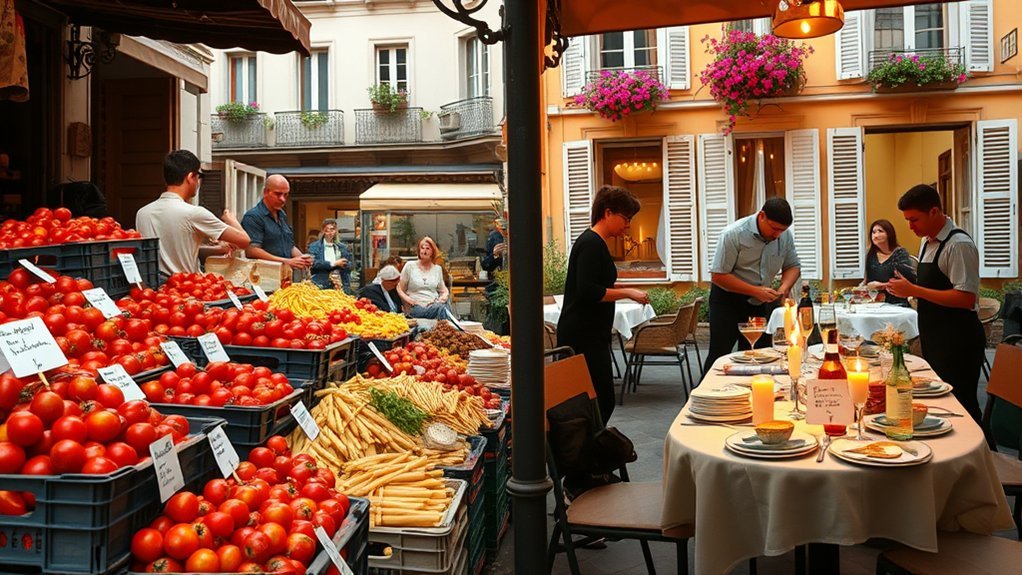
When you shop in Milan, expect everyday groceries to be reasonably priced but eating out to add up quickly: staples like 1 L of milk (€1.49), a 500 g white loaf (€2.45), 1 kg rice (€2.95) and a dozen eggs (€4.14) keep home cooking affordable, while common produce—apples (€2.42/kg), bananas (€2.12/kg), tomatoes (€3.47/kg), potatoes (€2.13/kg) and onions (€1.85/kg)—fall into predictable ranges; a mid-range bottle of wine runs about €7 and beer about €2–€2.40.
You’ll find supermarket staples cover most meals, so plan weekly shopping to stretch a grocery budget. Eating out at Milan restaurants is particularly pricier: a mid-range three-course for two averages €80, with per-person ranges €12–€35. Fast food is convenient—McMeal ≈ €11—and a cappuccino costs about €1.90–€1.93.
For budgeting, prioritize cooking from supermarket staples and local produce prices, reserve restaurants and wine and beer for social occasions, and use quick meals selectively to control overall food prices.
Utilities, Internet and Mobile Costs
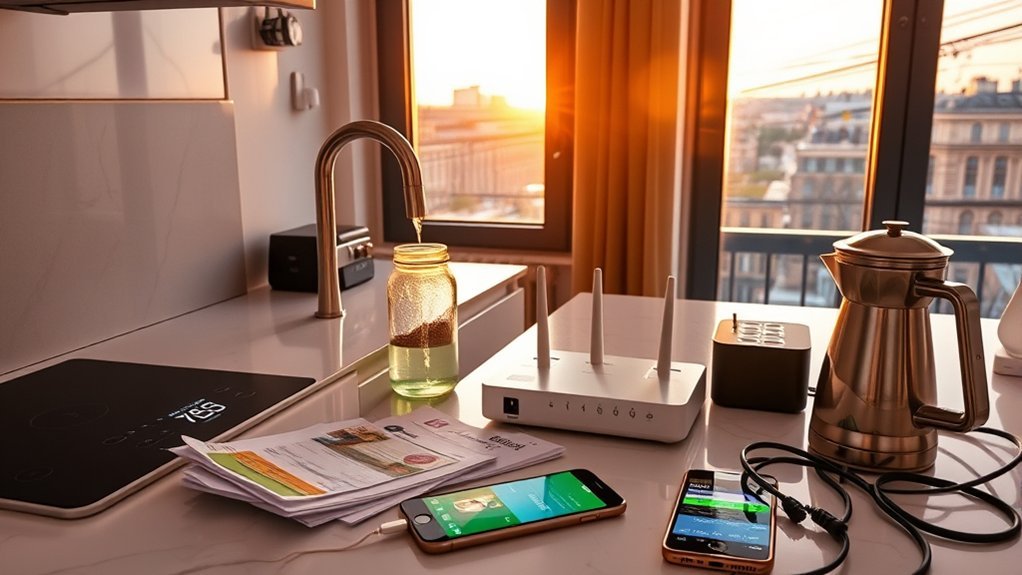
Factor in monthly utilities, internet and mobile bills from the start: basic utilities for an 85 m² apartment typically run about €186.64 (range €120–€303.57) but can spike in winter with heating, and condominium charges or riscaldamento are often billed separately and vary by building.
You’ll want to budget for electricity, heating, water and garbage as the core utilities figure; heating costs rise in colder months and larger or poorly insulated units cost more.
Add potential spese condominiali or riscaldamento charges that some buildings bill separately — these vary widely and can be fixed or consumption-based.
For connectivity, expect an internet (60 Mbps) unlimited plan around €26.39/month (typical €24–€30).
A mobile plan (10GB+) runs roughly €9.93/month (typical €7.90–€12.99).
Altogether, include these monthly bills when comparing offers or setting a monthly budget, and check contract details for billing cycles, extras and seasonal heating adjustments. Additionally, remember that operational expenses are crucial to consider when planning your overall budget, as they can significantly impact your financial stability.
Transportation and Commuting Expenses
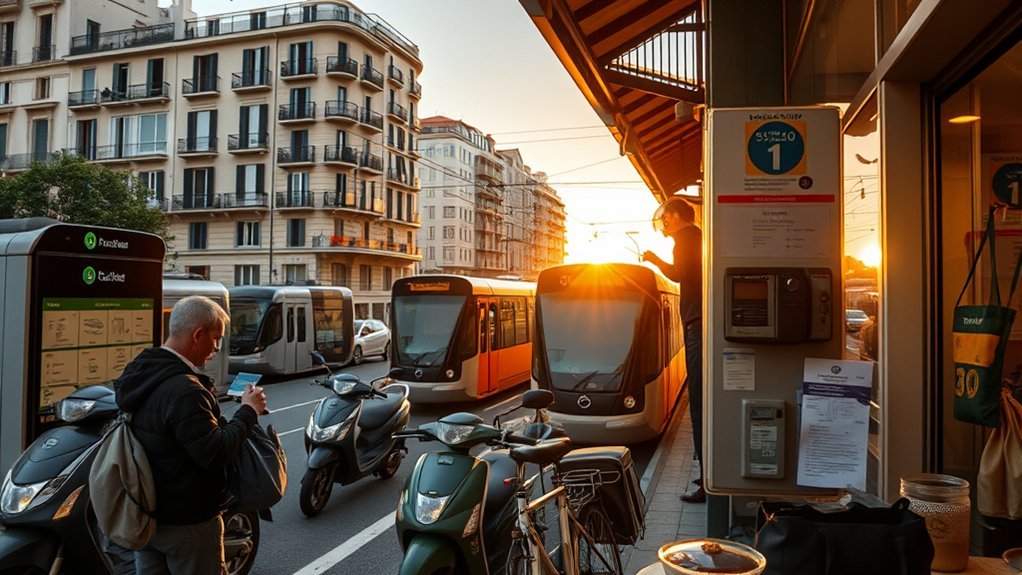
Once you’ve penciled in utilities and connectivity, look next at how you’ll get around Milan — daily travel can sway your monthly budget more than a phone bill. You’ll find Milan public transport efficient: a one-way ticket across metro tram bus is about €2.20, while a monthly pass runs near €39 (€22 reduced under‑27). If you commute long-term, an annual urban pass (~€330 adults, ~€200 younger) cuts per‑trip costs markedly.
Once utilities and connectivity are set, factor Milan commuting costs — metro/tram tickets €2.20, monthly ~€39.
Consider modal trade-offs analytically:
- Public transit + monthly pass: predictable commuting costs and wide coverage.
- Bike‑sharing / scooter‑sharing: low fees, many free initial minutes, excellent for short hops and first/last mile.
- Driving or taxis: taxi fares start ~€6–7 plus per‑km; with fuel price per litre ~€1.78–€1.81, driving raises commuting costs greatly.
It’s also wise to keep an eye on preventive measures like regular inspections of your vehicle’s air conditioning system to avoid unexpected expenses.
Use this to estimate monthly commuting costs based on frequency and distance, then pick the mix that minimizes time and expense for your routine.
Average Salaries, Budgeting and Money-Saving Tips
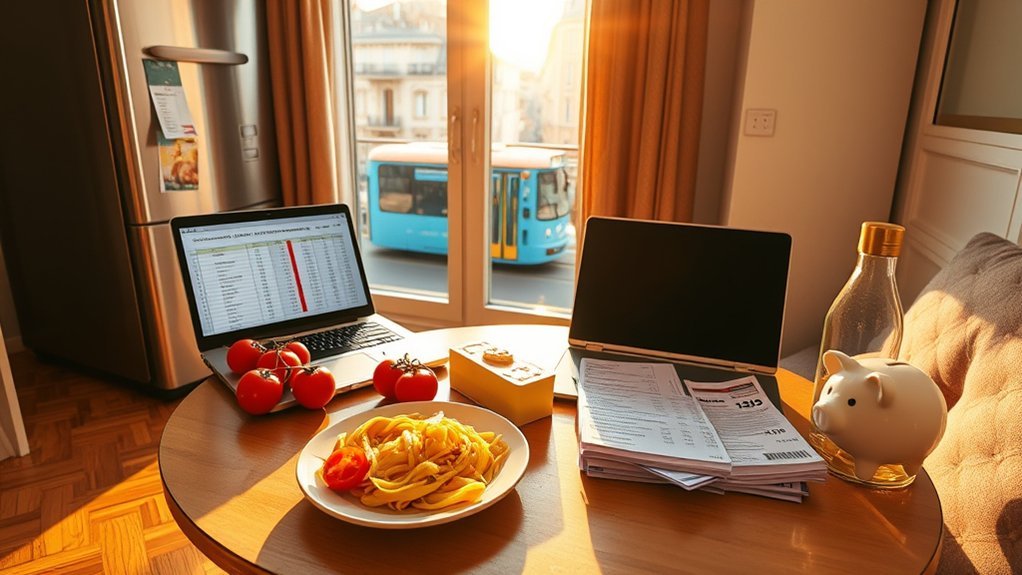
Although salaries in Milan can look healthy on paper, you should plan conservatively: many sources put the average net pay around €2,050 but realistic take‑home for many workers is closer to €1,600, so budget expectations should use the lower figure.
With the Milan cost of living high, compare that average monthly net salary to typical monthly expenses: non‑rent costs run €800–€1,000, so comfortable living usually needs €2,000–€2,400.
Rent prices are the main pressure—expect €1,200–€1,450 for a central 1‑bed or €800–€1,025 outside centre.
Practical budgeting tips: choose shared flats to cut housing—rooms go €350–€700—and prioritize saving for housing.
Trim food and groceries by packing a schiscetta and shopping local markets.
Use under‑27 discounts and a cheap public transport pass (~€22) or pick peripheral, metro‑connected neighbourhoods to lower utilities and bills.
Reduce subscriptions, pick a low‑cost mobile plan (~€10/month), and use libraries and free events to stretch income. Additionally, understanding local market conditions can help you make informed choices about your living expenses.
Frequently Asked Questions
What Is the Average Cost of Living in Milan?
You’ll pay roughly €1,800–€2,500/month depending on neighborhood differences and city vs suburbs; factor transport costs, groceries comparison, student budgets, healthcare expenses, entertainment spending, seasonal variations, short term rentals, digital nomads.
How Much Do Utilities Cost per Month in Italy?
Right off the bat, you’ll pay roughly €80–€220 monthly: utility bills (electricity usage, gas heating), water charges, garbage fees, condominium fees, municipal taxes, energy tariffs, internet plans, and varying billing cycles affect totals.
Can You Live on €3,000 a Month in Italy?
Yes — you can live on €3,000 monthly in Italy, but you’ll weigh remote work, student budgets, family expenses, digital nomads’ needs, expat taxes, health insurance, luxury lifestyle choices, side hustles, savings strategies, and seasonal costs carefully.
How Much Do You Need to Make to Live Comfortably in Milan?
You’ll need about €2,000–€2,400 net monthly to live comfortably in Milan; factor Salary benchmarks, Lifestyle choices, Tax implications, Commuting costs, Entertainment budget, Savings targets, Healthcare access, Family expenses, Work benefits and Savings strategies.
Conclusion
You’ll find Milan pricier than many Italian cities, but smart choices let you live well without breaking the bank. Test the theory that location matters more than salary: living near transit and buying local groceries cuts costs faster than chasing higher pay. Track rent, bills and commuting for a month, then adjust housing or habits based on the data. With deliberate budgeting, shorter commutes, and occasional dining out, you’ll keep quality of life high and expenses manageable.

